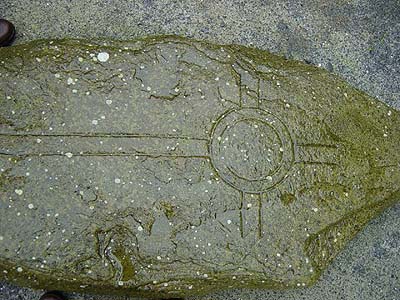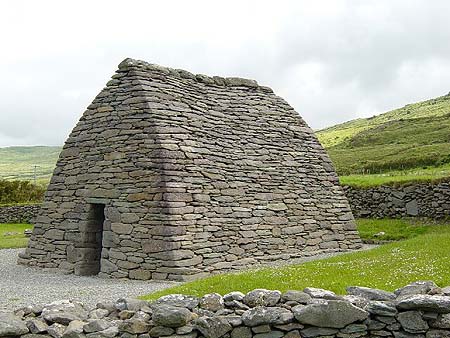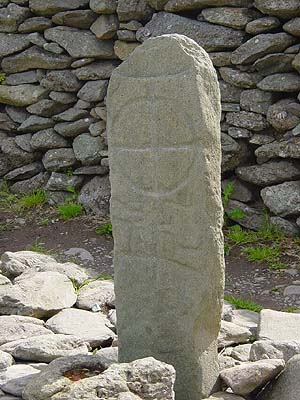and the Working Celtic Cross
|
Photographs by Maureen Palmer ©2002 CONTINUED... The ancient French seafaring port of St Malo is named after the Welsh Saint and is the birth place of Jacques Cartier who was the first European reputed to land in Canada in 1534 AD. St Brendan set forth on a voyage to find the Blessed Islands, a myth even in his time, They were looking for the Promised Land, a fabled place of plenty beyond the western horizon. I believe that these ancient legends came from the earlier sea voyaging "Celtic" peoples. Such legends may be seen in the funerary culture of Ancient Egypt thousands of years earlier. There are varying accounts of between 60 and 150 monks accompanying St Brendan on this hazardous voyage and the many accounts of their amazing adventures are well documented. Now, It is said that there is no smoke without fire and there is considerable evidence of artifacts in America that bear out the possibility that St Brendan made it in the steps of his Pagan ancestors. So is there evidence of pre Christian crosses being associated with Brendan? Is there an astronomical prehistoric understanding of astronomy and navigation indicated in the Ardfert crosses? The Cross Slab was found in the oldest level which has not yet been properly excavated and the stones were in an enclosure, Inside the Cathedral there are some exhibition boards of the site during the various periods of restoration and a photo of the Cross Slab. The note underneath it just said pre-historic, 'perhaps used as a boundary marker'.  Maureen Palmer wrote: "In the enclosure which houses the stones I noticed another one leaning against the wall. We were informed that it was the same period as the Cross Slab, but I noticed this one has the circle both top and bottom. What do you make of it?"
"The lower cross is a perfect image of the earliest sextant (astrolabe) known to Man. The Cross and Plumbline converted into the spinning wheel of the Celtic cross, an instrument that is stable at sea. The upper part of the double cross is the same as the shapes worn on the chests of the Knights Templar 700 years later. It is also the same style as the depictions on the sails of St Brendan's ship, as well as that of Christopher Columbus and it implies a deep understanding of the motions of Precession. The angles formed by the cross arms represent the seasonal 46.8 degree wobble of the earth, that results in our four seasons. This astronomical knowledge was inherited from our pre historic ancestors that built stone henge and the pyramids. With the working Celtic cross, you can find both latitude and longitude, since it allows the user to both measure the angle of heavenly bodies and tell the time at a local level as well as at a prime meridian." Here is more from Maureen Palmer: "I think Brendan probably got his Knowledge from the 'Beehive' peoples. Nothing much is›known about these peoples, there is no written history, but their monuments›and dwelling places show they had an amazing knowledge of structure and they lived always very close to the coastline in houses similar in shape to Beehives. One of the few Heritage pre-Christian protected monuments constructed by the Beehive Peoples is what is called 'The Oratory' situated at Gallerus on the Dingle peninsula. This structure is built in the shape of an upturned boat, and aligned in such a manner that the Sun entered a small window facing East in the morning and entered the doorway›facing ›West in the evening. The building method they used is what is known as 'corbelling', they did not›use any mortar in these constructions, yet in all the hundreds of years that this monument has stood not one single drop of rainwater has seeped inside." The Oratory [pictured below], although quite ancient was built on an even older site and guess what I found there?
 Make up your own mind. Did Brendan cross the ocean with only an image of stone in his head, or did he have a living working cross like this one? [pictured below]
 Is the net finally closing on the truth about our ancient seafaring past? Was Brendan another of those adventuring stalwarts who made it to America like his ancestors before him, using an even older knowledge of stellar navigation than we can yet comprehend? Watch this space for the stories of the Essenes, Phoenicians, Minoans and the famous "Sea Peoples."
|

Other history related articles on this site:
.
.
.
.
.
.
.
.
.
.
.
.
If you have a suggestion or history related article to submit, send it to:
Editor/viewzone.com
myristicin@hotmail.com
 What Crichton makes of it is the following:
What Crichton makes of it is the following:
